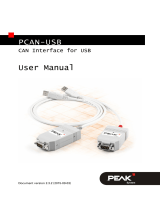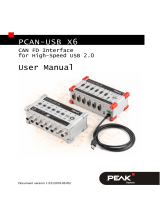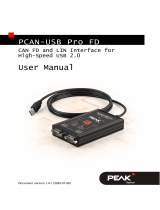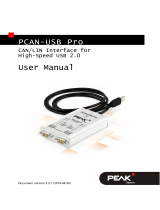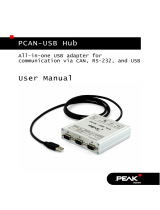
PCAN-USB Hub – User Manual
5
1 Introduction
The PCAN-USB Hub provides multiple hardware interfaces through
a USB connection. It offers the user one CAN, two RS-232, and two
further USB interfaces. Its robust aluminum casing makes the
PCAN-USB Hub suitable for mobile applications. Device drivers and
programming interfaces exist for different operating systems, so
programs can easily access a connected CAN bus.
Tip: At the end of this manual (Appendix C) you can find a
Quick Reference with brief information about the installation
and operation of the PCAN-USB Hub.
1.1 Properties at a Glance
High-speed USB 2.0 hub with
• CAN interface, D-Sub 9-pin connector
(in accordance with CiA® 102)
• Two RS-232 ports, D-Sub 9-pin connectors
• Two High-speed USB 2.0 downstream ports
Passive (bus-powered) hub operation through the USB port of a
PC enables power consumption of up to 100 mA per USB
channel
Active (self-powered) hub operation through the optional
external hub power supply (9 - 36 V) enables power
consumption of up to 500 mA per USB channel
Guaranteed high transfer rates on all channels if a Full-speed
device is connected, thanks to a hub controller with 4
transaction translators
CAN bit rates from 5 kbit/s up to 1 Mbit/s




















